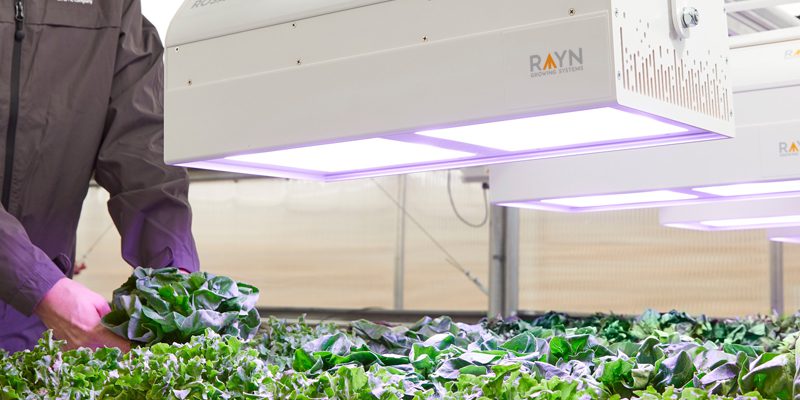This Q&A with Technical Salesperson Hannah Ball was originally shared by AgriTechTomorrow.
Tell us about RAYN Growing Systems and your role with the company.
RAYN Growing Systems provides researchers and growers with technologically advanced horticultural lighting solutions. Our parent company, ETC, has pioneered advancements in lighting science, LED technology, and system-wide controls for the entertainment industry for over 45 years. Now, we’re using that technology in horticulture lighting. RAYN’s full spectrum LED grow lights and precise controls enable plant researchers to reliably execute any experiment. For the grower aiming to maximize yield while minimizing costs, RAYN’s greenhouse lights deliver energy efficiency and ease of use. Working in Technical Sales for RAYN, I work closely with customers to listen to the needs of their growing operation and determine the best lighting solutions for them.
Why do you focus on LED in your horticultural lighting products?
In 2018, ETC’s late CEO and Founder Fred Foster began reading more and more about LED lighting for growing plants. He was specifically interested in studies exploring how LED wavelengths impact plant growth. ETC already had spent many years developing LED technology that delivers nuanced color and complex control to Broadway-scale theatrical productions. Now, RAYN Growing Systems has taken that advanced LED technology and adapted it to serve indoor growing needs. Energy efficiency, spectral control, and reduced labor needs are among the reasons that we’re focusing on creating LED solutions for indoor farms of the future.
You offer solutions for both plant researchers and indoor farmers. Can you talk a little bit more about the differences and similarities you’d see in these growing operations?
Luminaires for plant researchers are designed for the grower to adjust the light to reach their goals. Researchers need flexibility in spectrum and intensity as well as precise control to create reliable experiment conditions. Our Rosa luminaire is an example of a full spectrum LED grow light designed for research, with 13 color waveband options. The Lyda LED grow light bar also offers two distinct spectral recipes depending on the grower’s needs. Production farms are looking for luminaires that are cost-effective and easy to use and install. RAYN’s Fotono greenhouse light aims for that simplicity in design for growers, but also incorporates some qualities of a research fixture, with tunable white functionality that gives growers the ability to adjust spectral content for each crop phase.
Your Fotono LED luminaire is a direct replacement for HPS lights. What kind of ROI can growers expect from making the switch?
LED luminaires greatly reduce energy consumption when compared to an HPS grow light. On a light-by-light basis, a 1000W DE HPS grow light costs $1.85 to run per day on average, while a comparable LED grow light costs under $1.00 to operate. The energy savings over time greatly contribute to the ROI of an LED system. Labor and maintenance costs are other areas where a greenhouse operation would increase savings in an LED system. HPS grow lights require an annual lamp change. In an operation with 436 fixtures, the greenhouse would be looking at saving about $32,000 per year by eliminating the need to purchase and install new lamps in the HPS lights. With the RAYN Fotono fixture, a greenhouse would be guaranteed 5 years maintenance free to keep the lights running efficiently.
What needs to happen to make vertical and indoor farming a longterm viable solution for food production?
One of the largest challenges I see for vertical farming and indoor growing is the cost to both build and maintain an operation. In the long-term, the industry needs to figure out how to manage associated power costs, labor costs, and more that prevent indoor farms from growing to scale. Advancing the technology used in these operations could be a solution for increasing efficiency and reducing labor. We also know that vertical farming works well for certain types of crops, such as herbs, leafy greens, and berries. Expanding the variety of crops that are suitable for indoor growing would make vertical and indoor farming an even more viable solution for feeding the world’s population. The RAYN team believes that indoor farming will be important for the future of our planet. We aim for our solutions to help facilitate global food security, save water, and reduce the use of herbicides and pesticides.
Where are you seeing the most growth and demand for your product? Vertical farming, Cannabis, Research, Greenhouses?
As a young company in the horticulture lighting market, we truthfully are seeing interest from all segments at the moment. I’ve been in conversation with growers in research spaces, greenhouses, vertical farms, and more.
What are your plans for growing with the indoor farming industry? Do you anticipate new product or technology in the near future?
We are always developing new technology and new products. We also meet the changing horticulture lighting needs of indoor growing operations by offering custom solutions. We invite growers to come to us with their specific needs and the RAYN team will figure out how we can make the technology work for them. We view ourselves as not just a vendor, but a partner to our customers.
Hannah Ball is a technical salesperson at RAYN Growing Systems. She connects with growers to develop new business opportunities in the research-based and commercial production horticultural lighting markets.
